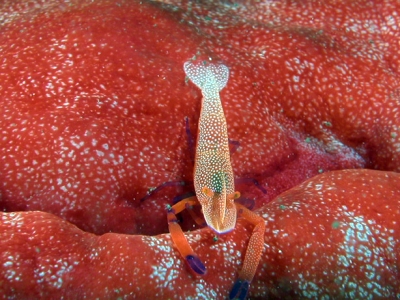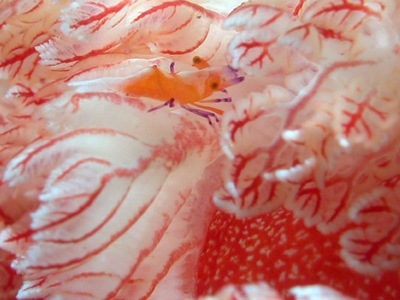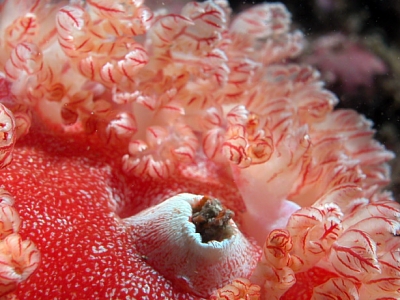The secret life on Hexabranchus sanguineus
December 5, 2007
From: David Mullins


Dear Bill,
I notice that the forum has 2 pages of information on Hexabranchus sanguineus, but how much is enough?
Locality: Old Woman Island (Mudjimba Is.), Maroochydore,, 14 metres, Queensland, Australia, Pacific Ocean, 9 June 2007, Rocky reef. Length: 140 mm. Photographer: David Mullins.
The following pics show a specimen of Hexabranchus sanguineus hosting 2 very different species of "commensal" shrimp on its mantle and gills and appears in no way irritated by their presence. The crustacean on the gills [middle photo] appears to be a type of hinge-beak or perhaps humpback shrimp which I have not seen before.
I believe the shrimp on the mantle is Periclimenes imperator which is well known in this role on Dorids. It has managed to affect the colour and stippling of its slug host upon its body,one of its 2nd chelipeds and even the eye stalks.
My patience in focusing on the gills [lower photo] was "rewarded" quite unexpectedly with this scatological moment. Perhaps it was this close and constant attention that induced "the deed". Some observers have reported that the shrimp feed upon these fecal pellets and what appears to be remnants of one can be seen around the tail and anterior end of P. imperator.
Thanks Bill.
Kind regards,
David Mullins.
david@nudibranch.com.au
Mullins, D.A., 2007 (Dec 5) The secret life on Hexabranchus sanguineus. [Message in] Sea Slug Forum. Australian Museum, Sydney. Available from http://www.seaslugforum.net/find/21256
Dear David,
I haven't felt the need yet to say 'no more' for any species.
I am surprised at how few photos we have on the Forum of Periclimenes on Hexabranchus but if you do a search for Periclimenes on the Forum you will find lots of photos of it associated with other opisthobranchs. I am pretty sure the shrimp on the gills is a juvenile of Periclimenes imperator. The white-spotted colour form of your larger animal is not the usual colour form of this species which usually has a white band down the back and a wider white collar just behind the 'head' [see photo on Symbiosis Fact Sheet]. The white spots are usually present on the posterior end of the body. If you look carefully at the gill-dwelling animal you can see a faint whitish collar behind the head.
Faecal pellets can be a useful indicator of food specificity, and from the orange bits I can see in your photo I suspect it has been eating an orange sponge. JUst knowing the colour of its food is not enough but if you found an animal producing faecal pellets with orange bits and it was sitting on an orange sponge, or surrounded by an orange sponge it would be a valuable clue. In sponges that have siliceous spicules, finding large numbers of thsoe spicules in the faecal pellets is also a valuable clue, but sponge spicules are scattered all over the sea bottom, so finding an identifying a few sponge spicules from an slug's stomach may be misleading and just indicate that they don't wash their food before eating it.
Best wishes,
Bill Rudman
Related messages
-
Chromodoris or Hypselodoris?
From: Franco De Lorenzi, March 26, 2010 -
Washed up in north-western Australia
From: Sean Houlihan, February 23, 2010 -
Hexabranchus sanguineus from sthn Queensland
From: Gary Cobb, September 25, 2009 -
Juvenile Hexabranchus sanguineus from Reunion Island
From: Sully Bachel, May 8, 2009 -
Hexabranchus sanguineus from Maui, Hawaii
From: Chris Ryu, February 11, 2008 -
Hexabranchus sanguineus or Djibouti Giant?
From: Edward Dixon, September 17, 2007 -
Feeding Hexabranchus sanguineus from Tofo, Mozambique
From: Natasja Vandeperre, August 24, 2007 -
Re: Hexabranchus sanguineus video
From: Diane Hennelly, August 16, 2007 -
Hexabranchus sanguineus from Mozambique [2]
From: Natasja Vandeperre, August 11, 2007 -
Hexabranchus sanguineus from Mozambique [1]
From: Natasja Vandeperre, August 11, 2007 -
Spanish Dancer from Sydney
From: Donald Miles, July 11, 2007 -
Re: Nudibranch from the Seychelles, Indian Ocean
From: Jen Jenny, May 4, 2007 -
Nudibranch from the Seychelles, Indian Ocean
From: Jen Jenny, April 27, 2007 -
Hexabranchus sanguineus from Bali
From: Asther Lau, April 13, 2007 -
Hexabranchus behaviour
From: Sandrine Flodrops, December 4, 2006 -
Juvenile Hexabranchus from nthn New South Wales
From: Roxanne Fea, November 8, 2006 -
Re: Dancing 'Spanish Dancer'
From: Kamal El Tawil, September 1, 2006 -
Dancing 'Spanish Dancer'
From: Joseph De Vroe, August 25, 2006 -
Hexabranchus sanguineus from Indonesia
From: Kevin Lee, August 7, 2006 -
Re: Spanish Dancer Research Paper
From: Molly Ogden, July 29, 2006 -
Could this be a Spanish Dancer?
From: Brian Francisco, March 3, 2006 -
Kissing Hexabranchus sanguineus
From: Joseph De Vroe, November 8, 2005 -
Hexabranchus sanguineus with one gill
From: Joseph De Vroe, November 4, 2005 -
Mating Hexabranchus sanguineus
From: R. Grooters & M. Snoek, September 21, 2005 -
Re: Juvenile Hexabranchus
From: Colin Ogden, September 3, 2005 -
Juvenile Hexabranchus strikes again
From: Colin Ogden, September 2, 2005 -
Re: Hexabranchus sanguineus from Egypt
From: Kamal El Tawil, July 11, 2005 -
Hexabranchus sanguineus from Madagascar
From: Marco Angelozzi, July 4, 2005 -
Re: Hexabranchus sanguineus from Egypt
From: Kamal El Tawil, June 24, 2005 -
Hexabranchus sanguineus (Spanish dancer) from Egypt
From: Kamal El Tawil, June 7, 2005 -
Re: Hexabranchus juvenile from the GBR
From: Nils Anthes, January 15, 2004 -
Hexabranchus juvenile from the GBR
From: Nils Anthes, January 10, 2004 -
Hexabranchus sanguineus unrolling the mantle
From: Erwin Koehler, December 16, 2003 -
Gills on Hexabranchus sanguineus
From: Gary Cobb, December 11, 2003 -
Juvenile Hexabranchus
From: Roberto Sozzani, May 19, 2003 -
Hexabranchus from Myanmar
From: Mary Jane Adams, May 2, 2003 -
Spanish Dancer Research Paper
From: Molly Ogden, April 29, 2003 -
Hexabranchus mating photos
From: Bill Rudman, March 4, 2003 -
Hexabranchus sanguineus from Lord Howe Island
From: W.B. Rudman, January 23, 2003 -
Hexabranchus juvenile from Bali
From: Danny Van Belle, January 9, 2003 -
Spanish Dancer - What can we feed it?
From: Shawn Elston, November 18, 2002 -
Re: Hexabranchus - its common name
From: Constantine Mifsud, September 9, 2002 -
Hexabranchus - its common name
From: Jason Lewis, September 7, 2002 -
Size of Hexabranchus
From: Valeria Safonova, June 22, 2002 -
Juvenile Hexabranchus sanguineus from Christmas Id
From: W.B. Rudman, May 10, 2002 -
Juvenile Hexabranchus sanguineus
From: Mary Jane Adams, May 9, 2002 -
Hexabranchus sanguineus from the Red Sea
From: Marina Poddubetskaia , April 17, 2002 -
A report on the Spanish Dancer
From: Student, March 22, 2002 -
Hexabranchus sanguineus from Bali
From: Stuart Hutchison, March 21, 2002 -
Hexabranchus sanguineus - oral tentacles
From: Stuart Hutchison, March 21, 2002 -
Are these Spanish Dancers?
From: Reine, January 27, 2002 -
Hexabranchus? from South Africa
From: Allan Connell, December 17, 2001 -
Spanish Dancer?
From: Joyce Zwiener, December 14, 2001 -
Spanish Dancer
From: Belinda, September 7, 2001 -
Swimming Hexabranchus from the Red Sea
From: Luigi Montevecchi, August 28, 2001 -
Eggs of Hexabranchus sanguineus
From: Luigi Montevecchi, August 28, 2001 -
Re: Hexabranchus 'aureomarginatus' in Hawaii
From: John Hoover, August 3, 2001 -
Juvenile Hexabranchus from Hawaii
From: Scott Johnson, July 30, 2001 -
Hexabranchus 'aureomarginatus' from Hawaii
From: Scott Johnson, July 30, 2001 -
Hexabranchus 'pulchellus' from Hawaii
From: Scott Johnson, July 30, 2001
